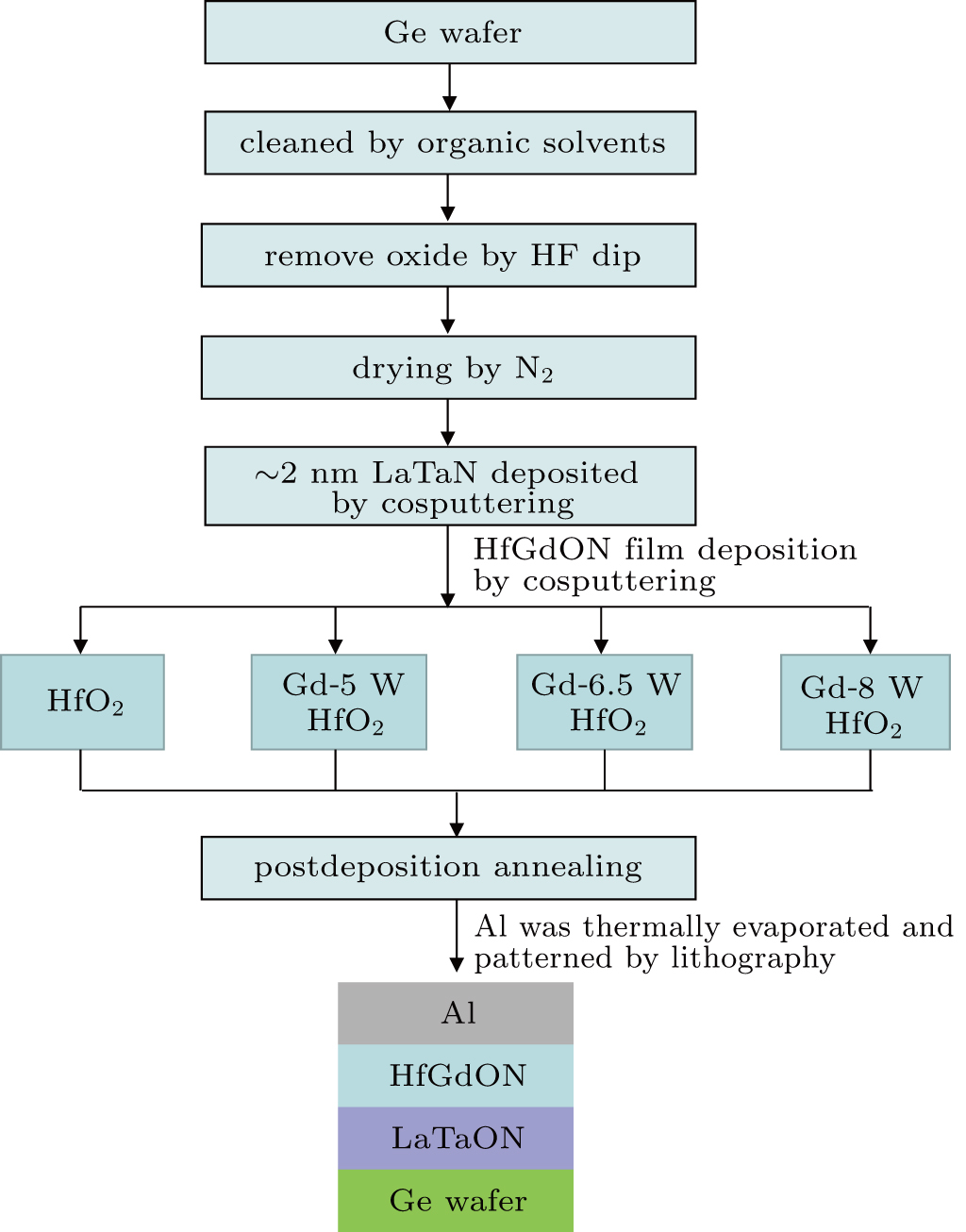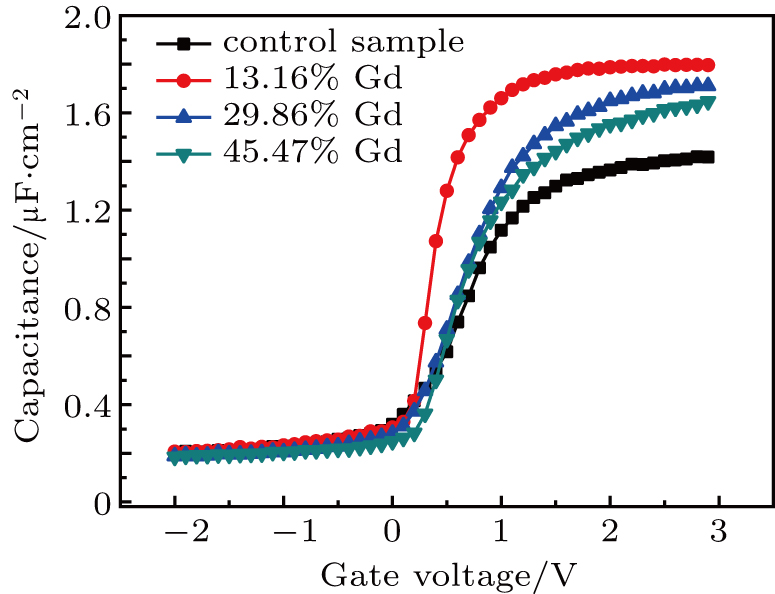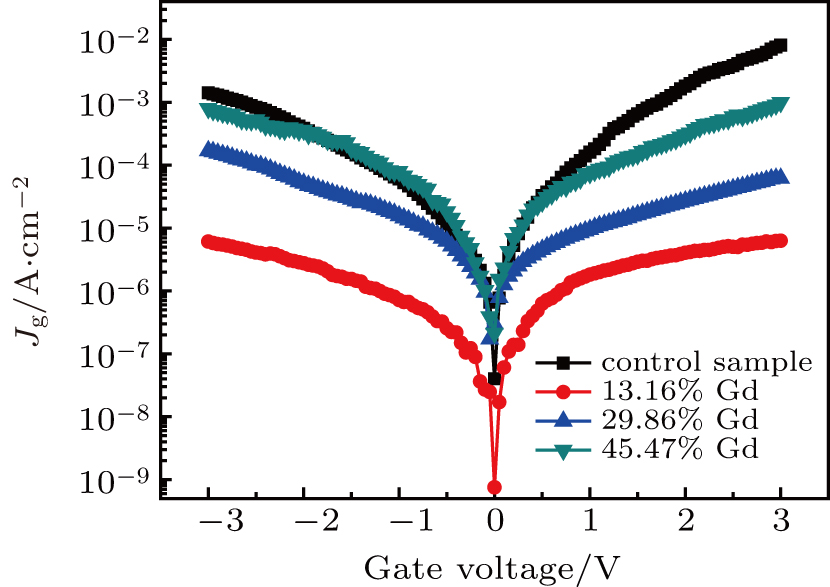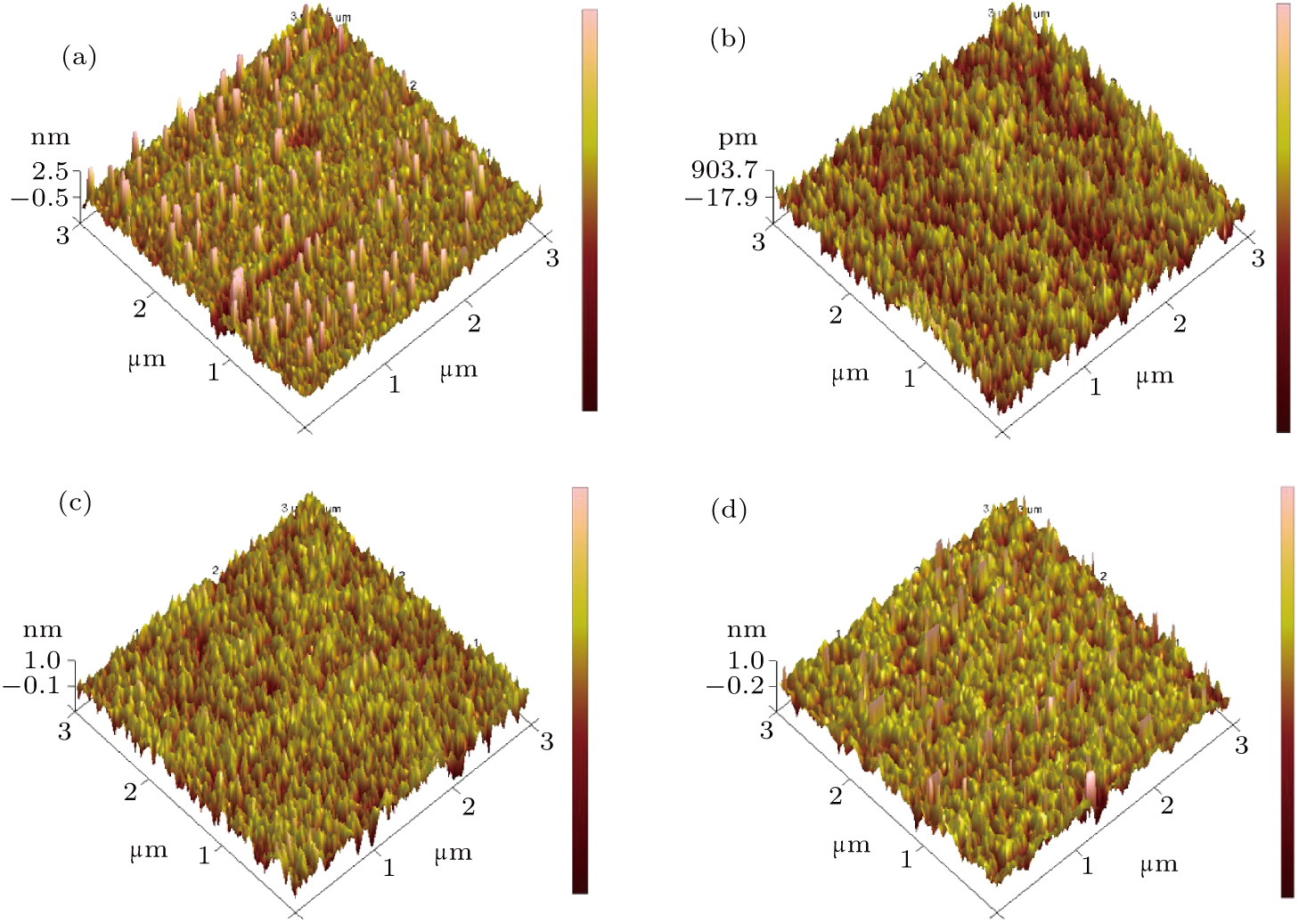† Corresponding author. E-mail:
Project supported by the National Key Research and Development Program of China (Grant No. 2018YFB2200500) and the National Natural Science Foundation of China (Grant Nos. 61851406 and 61274112).
High-quality dielectric/Ge interface and low gate leakage current are crucial issues for high-performance nanoscaled Ge-based complementary metal–oxide–semiconductor (CMOS) device. In this paper, the interfacial and electrical properties of high-k HfGdON/LaTaON stacked gate dielectric Ge metal–oxide–semiconductor (MOS) capacitors with different gadolinium (Gd) contents are investigated. Experimental results show that when the controlling Gd content is a suitable value (e.g., ∼ 13.16%), excellent device performances can be achieved: low interface-state density (6.93 × 1011 cm−2 · eV−1), small flatband voltage (0.25 V), good capacitance–voltage behavior, small frequency dispersion, and low gate leakage current (2.29× 10−6 A/cm2 at Vg = Vfb + 1 V). These could be attributed to the repair of oxygen vacancies, the increase of conduction band offset, and the suppression of germanate and suboxide GeOx at/near the high k/Ge interface by doping suitable Gd into HfON.
Recently, it has become increasingly difficult in further scaling down the geometric dimension of Si-based metal–oxide–semiconductor field-effect transistor (MOSFET). For overcoming the obstacle, Ge-based and III–V compound semiconductor-based MOSFETs (e.g., GaN-HEMTs) with high-k gate dielectric have been extensively studied to further improve the scaled CMOS technology due to their higher electron and/or hole mobilities than those of silicon.[1–6] For Ge MOS, unstable and water-soluble GeOx (x < 2) degrades the Ge/gate-dielectric interface quality, resulting in poor electrical properties,[7] which has hampered the development of Ge MOSFET. In order to solve this problem, different surface passivation layers, such as LaTaON,[8] ZrON,[9] NbSiON,[10] etc.[11–14] have been investigated and exhibited good interface quality in the presence of Ge. On the other hand, Hf-based oxide has been considered as one of the most promising high-k materials and used as gate dielectric due to its high k value (∼ 25) and large band gap (∼ 5.8 eV).[15,16] However, it has been found that the electrical properties of the device will be degraded due to intermixing between Ge and Hf.[1,2,7–14] Although the incorporation of nitrogen (N) into HfO2 could suppress Ge and O diffusion and improve the interfacial property,[17,18] it reduced the valence- and conduction-band offsets.[19] Fortunately, some recent investigations have demonstrated that the Gd-doped HfO2 can increase the conduction-band offset and transform HfO2 from the monoclinic phase to the cubic phase, thus diminishing the leakage, improving the interface quality, and also augmenting the k value of dielectric.[20,21] So in this work, the effects of Gd content in HfGdON gate dielectric on interface and electrical properties of Ge MOS devices with LaTaON interlayer are further investigated so that Gd content is optimized to obtain high-quality dielectric/Ge interface and excellent device performances.
Ge MOS capacitors were fabricated on (100) n-type Ge wafers with a resistivity of 0.02 Ω · cm–0.1 Ω · cm. The wafers were cleaned by using ethanol, acetone, and trichloroe-thylenein in sequence, followed by dipping them in diluted HF (1:50) for 30 s, and then rinsed with deionized water for several cycles to remove the native oxide. After drying by N2, the wafers were transferred immediately to the vacuum chamber of a sputtering system. Before deposition, the vacuum chamber was evacuated to a base pressure of 5.0 × 10−4 Pa. A ∼ 2-nm LaTaN film was deposited by cosputtering of La target and Ta target at room temperature in an Ar/N2 (= 15/6) ambient atmosphere, followed by an in-situ deposition of ∼ 8-nm HfGdON film by cosputtering of HfO2 target and Gd target in the same ambient. The Gd content was adjusted by changing the Gd-target power as shown in Fig.
High-frequency (HF, 1 MHz) capacitance–voltage (C–V) and gate leakage current density versus gate voltage (Jg–Vg) characteristics were measured by HP4284A precision LCR meter and Keithley 4200-SCS semiconductor parameter analyzer respectively under a light-tight and electrically-shielded condition at room temperature. The physical thickness of the gate dielectric was determined by a spectroscopic ellipsometer. The x-ray photoelectron spectroscopy (XPS) was employed to investigate the compositions and chemical states of the samples.
The compositions and chemical states of four samples with different Gd contents (from 0 to 45%, as analyzed below) are investigated by etching the HfGdON gate dielectrics to a thickness of ∼ 4 nm from the Ge surface using an in-situ Ar+ ion beam in the XPS chamber. The binding energy is calibrated by centering the Ge 3d at 28.8 eV, and all peaks have their own fixed full wide at half maximum (FWHM). Firstly, the spectrum of La 3d is shown in Fig.
 | Fig. 2. XPS spectrum of HfGdON/LaTaON/Ge MOS with Gd content of ∼ 13.16% for (a) La 3d and (b) Ta 4f. Other samples with Gd incorporation have similar results. |
The Gd 4d core-level spectrum is shown in Fig.
 | Fig. 3. XPS spectra of HfGdON/LaTaON/Ge MOS with Gd content of ∼ 13.16% for (a) Gd 4d and (b) N 1s. Other Gd-doped samples have similar results. |
Figure
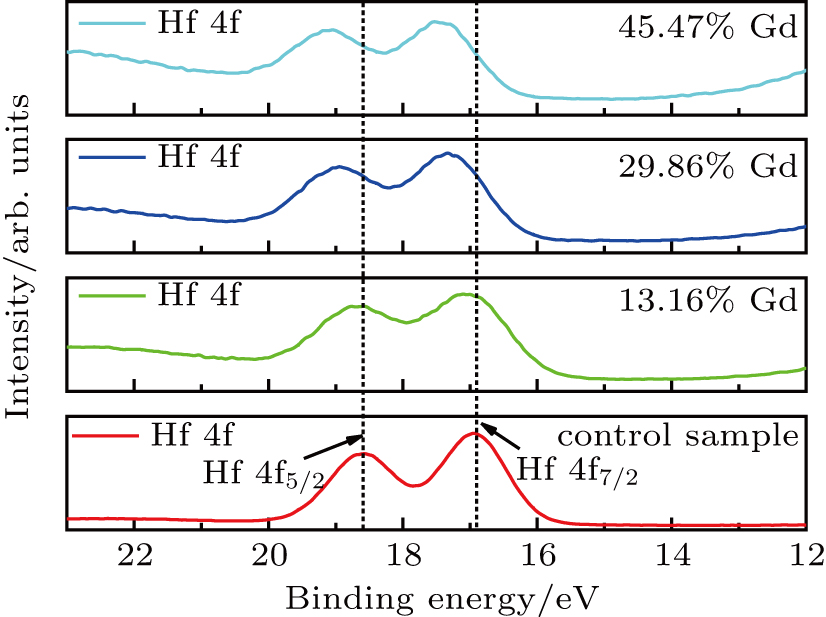 | Fig. 4. XPS spectra of Hf 4f for four samples with (a) 0% Gd, (b) 13.16% Gd, (c) 29.86% Gd, and (d) 45.47% Gd. |
Because of a strong overlap between the Ge 3d peak and Hf or Ta peak,[8,31] the Ge 2p3/2 core level spectrum for each of four samples is used to investigate interfacial quality between the high-k stack and Ge substrate as shown in Fig.
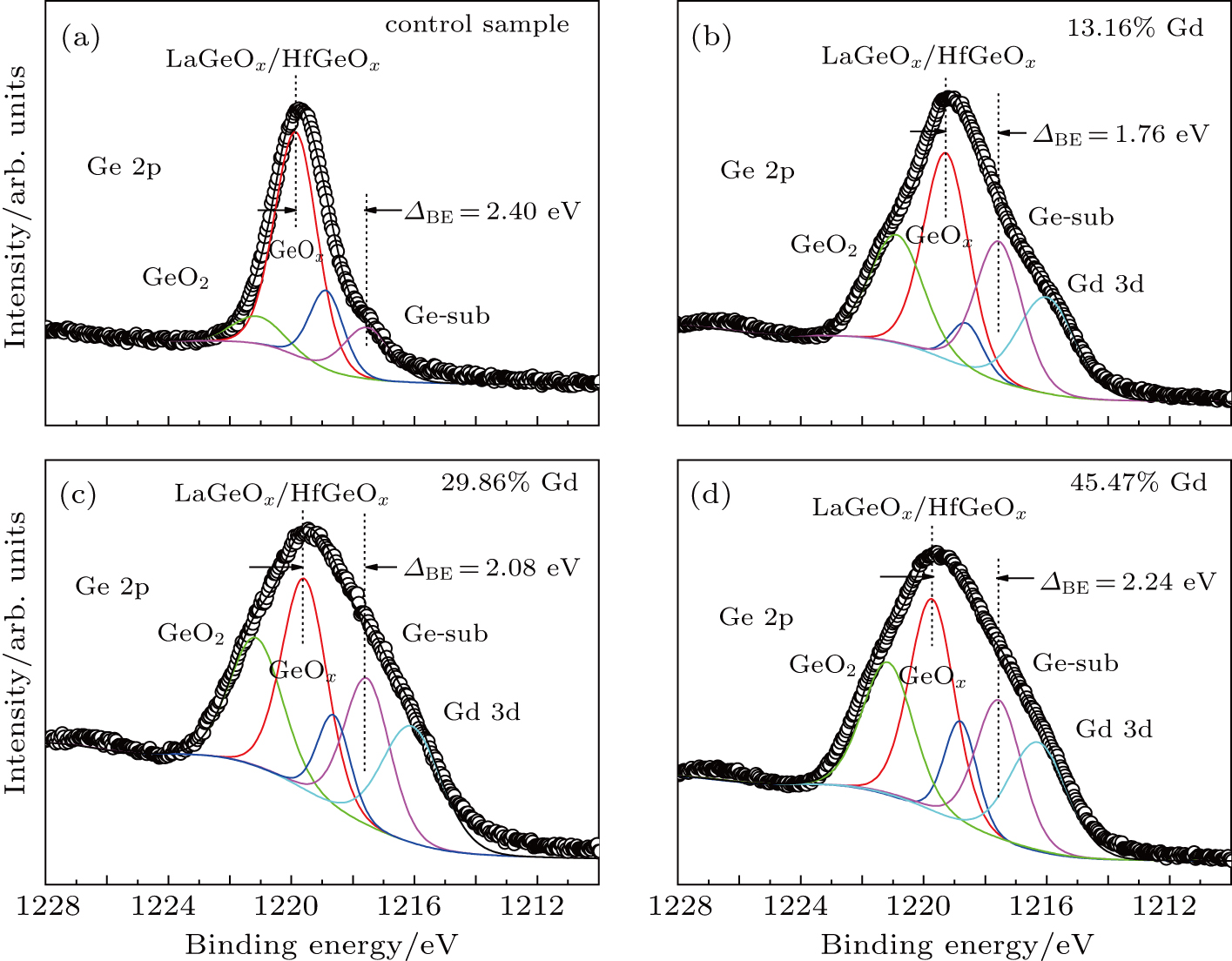 | Fig. 5. XPS spectra of Ge 2p for four samples with (a) 0% Gd, (b) 13.16% Gd, (c) 29.86% Gd, and (d) 45.47% Gd. |
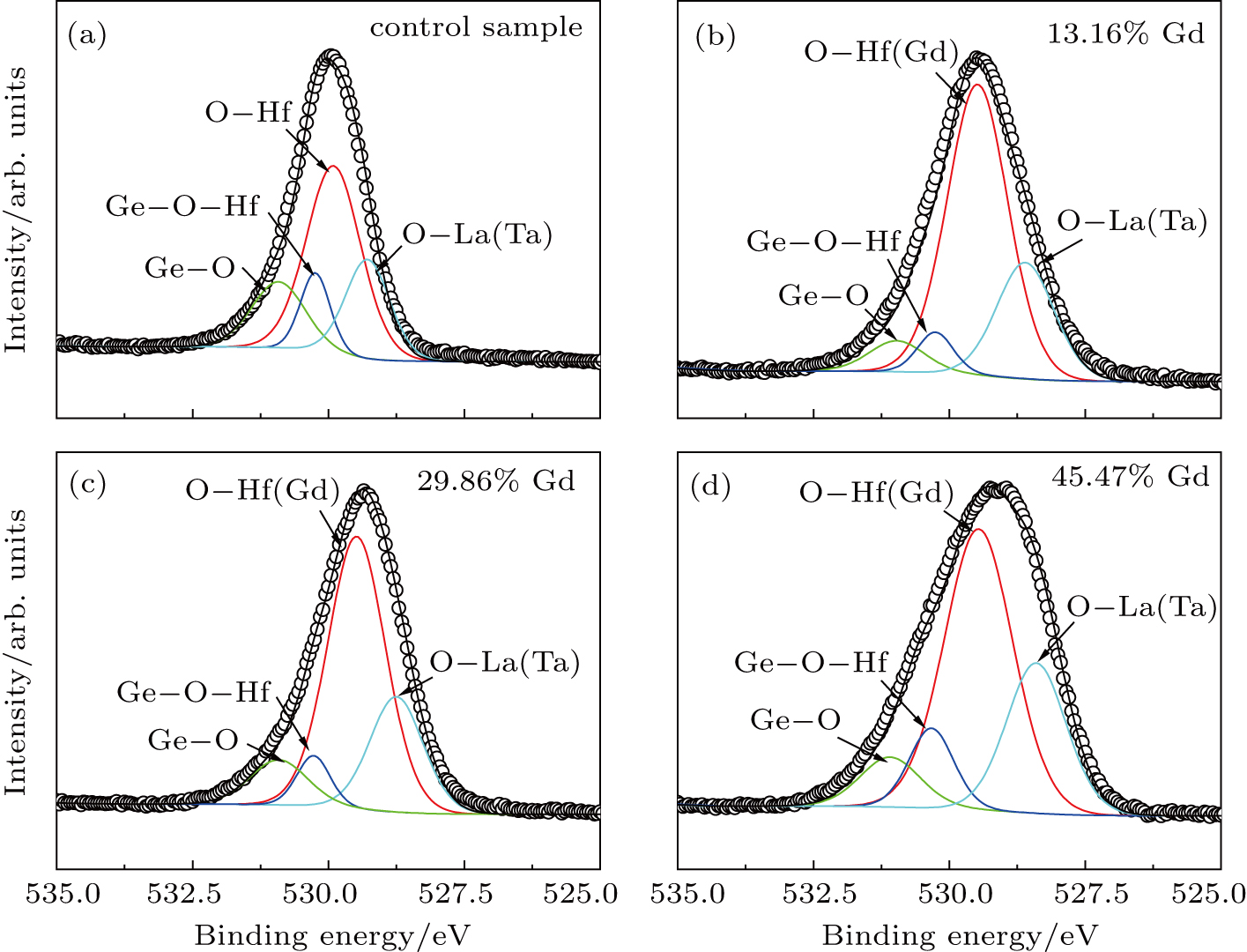 | Fig. 6. XPS spectra of O 1s for four samples with (a) 0% Gd, (b) 13.16% Gd, (c) 29.86% Gd, and (d) 45.47% Gd. |
Based on the above XPS analyses, it can be suggested that the incorporation of an appropriate amount of Gd into HfON can suppress the formation of germanate and suboxide GeOx, and however, excessive Gd incorporation into HfON will be counterproductive. So it is important to control the Gd content entering into HfON for the purpose of improving the interfacial quality between HfGdON dielectric and Ge substrate.
Figure
The permittivity can be calculated from[37] k = (1+8π am/3Vm)/(1 − 4π am/3Vm) where am denotes the molecular polarizability and Vm is the molecular volume. Obviously, the k value of HfGdON dielectric increases with the molecular polarizability increasing. In addition, the k value of the monoclinic HfO2 is lower than that of the cubic HfO2. With the Gd incorporation, the content of longer O–Gd bond increases as confirmed by the XPS spectrum of O 1s, and the monoclinic HfO2 is transformed into the cubic HfO2 due to substitution of O–Gd for O–Hf,[20] which plays a role in increasing k value too. But the k value will not always increase with the Gd content increasing as demonstrated by the measured results. The extracted electrical parameters from the C–V curves are listed in Table
| Table 1. Electrical and physical parameters extracted from the HF C–V curve of four samples. . |
The hysteresis behaviors of the C–V curves for the four samples are presented in Fig.
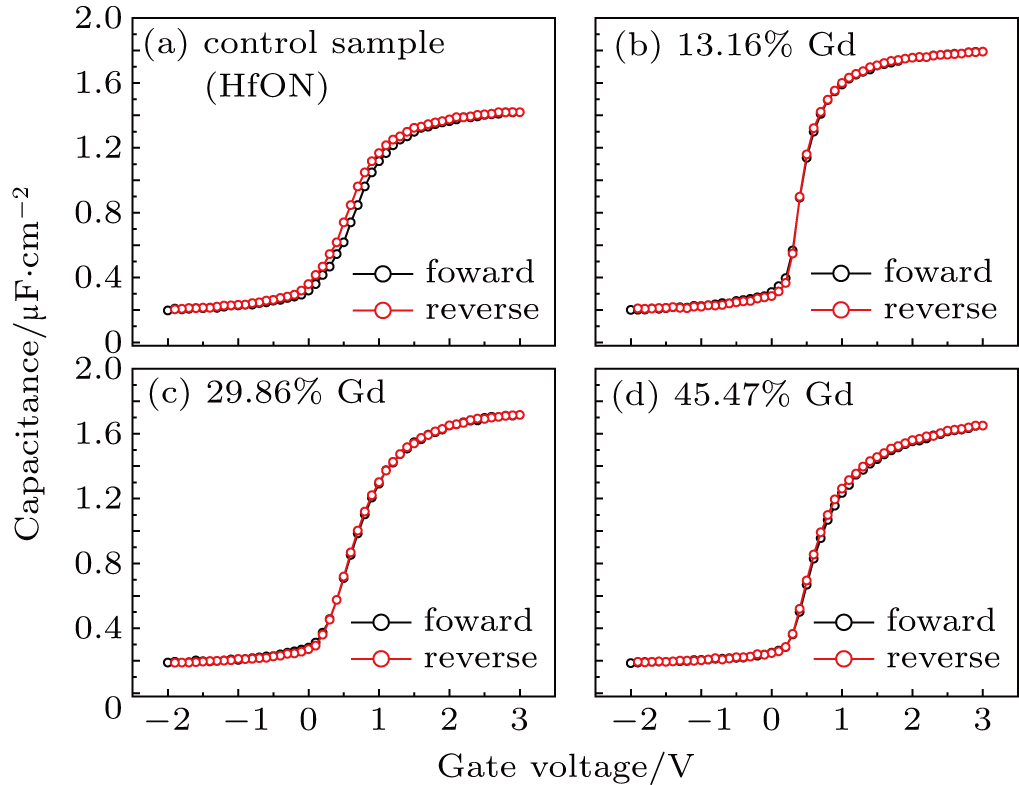 | Fig. 8. Hystereses of C–V curves for four samples with (a) 0% Gd, (b) 13.16% Gd, (c) 29.86% Gd, and (d) 45.47% Gd. |
To further illustrate the interface quality of the samples, the frequency dispersions of the C–V curves for the four samples are shown in Fig.
 | Fig. 9. Frequency dispersion of C–V curves for four samples with (a) 0% Gd, (b) 13.16% Gd, (c) 29.86% Gd, and (d) 45.47% Gd. |
Figure
In addition, the AFM images of the gate–dielectric surface of all the samples are shown in Fig.
In summary, the effects of the Gd content in HfGdON gate dielectric on interfacial and electrical properties of the Ge MOS capacitor with LaTaON as interlayer are investigated. It is found that reasonable Gd incorporation in HfON (e.g., ∼ 13.16% Gd) exhibits superior interfacial and electrical properties, which is due to the formation of less germanate and the suppression of unstable Ge suboxides. Furthermore, the Gd-doped HfON can obtain larger conduction band offset (ΔEc) and effectively suppress the formation of oxygen vacancies, which contributes to small gate leakage current (2.29 × 10−6 A/cm2 at Vg = Vfb + 1 V) and low interface-state density (6.93 × 1011 cm−2 ·eV−1) for the 13.16%-Gd sample. However, when excessive Gd is incorporated, the performance of the device is deteriorated due to the distortion of crystal structure and poor interface quality. For Gd content below 13.16%, it deserves to further investigate their effects on device performances for determining the optimal Gd content in the gate stacked dielectric of HfGdON/LaTaON, and thus achieving more excellent electrical performance of Ge MOS device.
| [1] | |
| [2] | |
| [3] | |
| [4] | |
| [5] | |
| [6] | |
| [7] | |
| [8] | |
| [9] | |
| [10] | |
| [11] | |
| [12] | |
| [13] | |
| [14] | |
| [15] | |
| [16] | |
| [17] | |
| [18] | |
| [19] | |
| [20] | |
| [21] | |
| [22] | |
| [23] | |
| [24] | |
| [25] | |
| [26] | |
| [27] | |
| [28] | |
| [29] | |
| [30] | |
| [31] | |
| [32] | |
| [33] | |
| [34] | |
| [35] | |
| [36] | |
| [37] | |
| [38] | |
| [39] |



